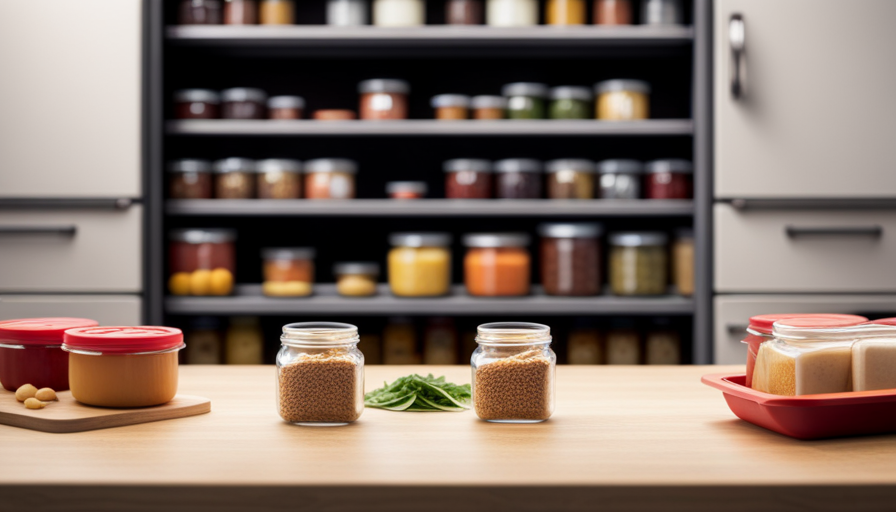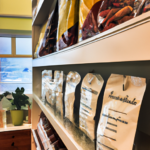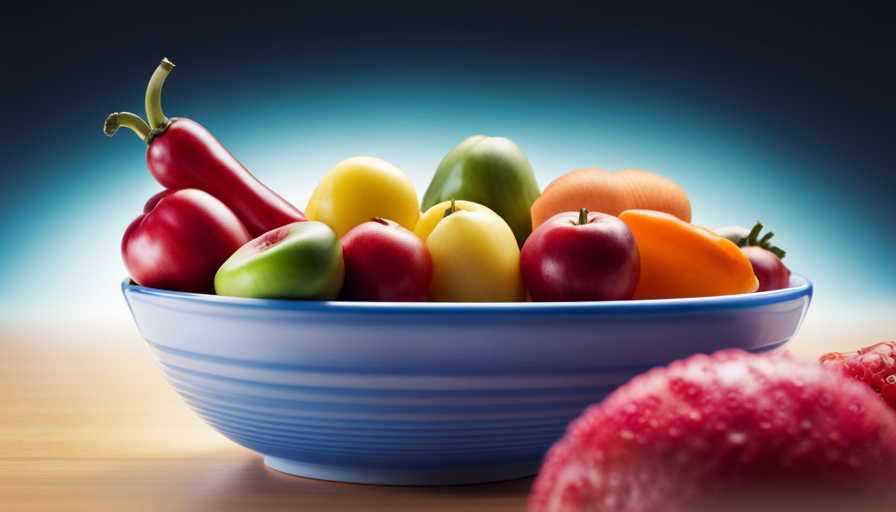Are you craving a group of like-minded people who are enthusiastic about raw food? Much as a seed seeks rich earth, so can you nurture a flourishing raw food cooperative.
Much like a garden, a raw food co-op is a place where like-minded individuals come together to nurture and grow their love for raw, unprocessed, and wholesome foods. Finding others who share your enthusiasm may seem like searching for a needle in a haystack, but fear not! With a little guidance, you can sow the seeds of a vibrant raw food community.
In this article, we will provide you with the essential steps to kickstart your own raw food co-op. From researching local regulations to establishing a membership structure, we will guide you through the process of nurturing your co-op from its inception to its flourishing growth.
So grab your gardening gloves and let’s dig in!
Key Takeaways
- Research local regulations and establish a membership structure to ensure compliance and organization.
- Find like-minded individuals through existing networks, online communities, and local health events to build a strong community.
- Source fresh and local raw foods to provide high-quality and sustainable options, while supporting local farmers and the economy.
- Establish efficient distribution and sharing systems, collaborate with local businesses, and utilize online platforms for coordination and information sharing.
Finding Like-Minded Individuals
Joining a raw food co-op is a fantastic way to connect with other passionate individuals who share your love for healthy, organic living. Finding potential members for your raw food co-op can be an exciting and rewarding process. Here are some practical steps to help you build a network of like-minded individuals.
First, start by reaching out to your existing network. Talk to friends, family, and colleagues who are interested in raw food and see if they’d be interested in joining your co-op. They may also be able to connect you with others who share the same interests.
Next, expand your search online. Join raw food forums, social media groups, and online communities focused on healthy living. Participate in discussions and share your passion for raw food. This will help you connect with individuals who are already interested in the raw food lifestyle.
Another great way to find potential members is by attending local health and wellness events. Look for workshops, seminars, and festivals that focus on organic living. These events are a great opportunity to meet people who are enthusiastic about raw food and are likely to be interested in joining a co-op.
Lastly, consider hosting your own raw food events. Organize potlucks, cooking demos, or educational sessions where you can meet like-minded individuals in your community. This will not only help you build your network but also create a sense of community among raw food enthusiasts.
By following these steps, you’ll be well on your way to finding like-minded individuals and building a strong network for your raw food co-op.
Researching Local Regulations and Laws
Exploring the local regulations and laws is crucial when setting up a collective for fresh, unprocessed sustenance. Understanding legal requirements and ensuring compliance with health and safety regulations should be your top priorities. Here are a few key points to consider when researching local regulations and laws for your raw food co-op:
-
Permits and Licenses: Contact your local government agencies to understand the permits and licenses required to operate a food co-op. This may include a business license, food handler’s permit, and zoning permits.
-
Food Safety Standards: Familiarize yourself with the food safety regulations in your area. This includes proper food handling, storage, and sanitation practices. You may need to obtain a food safety certification or undergo regular inspections.
-
Storage and Transportation: Ensure you have appropriate facilities and equipment to store and transport raw food safely. This may involve refrigeration units, proper packaging, and temperature controls.
-
Labeling and Packaging: Familiarize yourself with the labeling requirements for raw food products. This may include providing accurate ingredient lists, nutritional information, and allergen warnings.
By thoroughly researching and understanding the local regulations and laws, you can ensure your raw food co-op operates legally and in compliance with health and safety standards. This will not only protect your customers but also establish trust and credibility within the community.
Defining Co-op Goals and Values
When defining your co-op goals and values, you’ll discover the incredible power of collective decision-making and the shared vision that drives you forward. Setting clear goals and values is crucial for the success of your raw food co-op. It will guide your actions, attract like-minded individuals, and create a strong foundation for your cooperative.
To set goals, start by brainstorming what you hope to achieve with your co-op. Consider both short-term and long-term objectives. Short-term goals could include building a strong member base, sourcing high-quality raw food products, and creating a welcoming community space. Long-term goals might involve expanding your co-op’s reach, promoting sustainable and ethical practices, and supporting local farmers and producers.
Defining your values is equally important. Values serve as guiding principles for your co-op’s operations and decision-making processes. They reflect your beliefs and shape the culture of your organization. Some common values in raw food co-ops include promoting health and wellness, supporting local economies, fostering environmental sustainability, and practicing transparency and fairness.
To engage the audience and make the process more interactive, consider using a table to outline your co-op’s goals and values. Here’s an example:
| Goals | Values |
|---|---|
| Build a strong member base | Promote health and wellness |
| Source high-quality raw food products | Support local economies |
| Create a welcoming community space | Foster environmental sustainability |
| Expand co-op’s reach | Practice transparency and fairness |
By setting goals and defining values, you’ll establish a clear direction for your raw food co-op and attract individuals who share your vision. It will serve as a roadmap for your cooperative’s journey towards success.
Establishing a Membership Structure
To establish a membership structure, you’ll need to carefully consider the framework that will shape the collective decision-making and shared responsibilities within your co-op.
Finding potential members is the first step. Look for individuals who are passionate about raw food and share your values and goals for the co-op. Spread the word through social media, local community groups, and health food stores to attract interested individuals.
Membership benefits play a crucial role in attracting and retaining members. Highlight the advantages of being part of the co-op, such as access to fresh, organic produce at discounted prices, educational workshops on raw food preparation, and the opportunity to connect with like-minded individuals. Emphasize the sense of community and support that comes from being part of a co-op.
Once you have identified potential members and communicated the benefits of joining, it’s important to establish a clear membership structure. Consider whether you want to have different levels of membership, such as full members who actively participate in decision-making and share responsibilities, and associate members who have limited involvement. Define the membership fees and any requirements, such as attending a certain number of meetings or volunteering a certain number of hours per month.
By carefully considering the membership structure and effectively communicating the benefits, you can attract committed individuals who will contribute to the success of your raw food co-op.
Creating a Cooperative Agreement
Once you’ve identified potential members and effectively communicated the benefits of joining, it’s essential to create a cooperative agreement. This agreement outlines the collective responsibilities and decision-making processes within your community. It serves as a guiding document that defines the roles, responsibilities, and expectations of each member involved in the raw food co-op.
When creating the cooperative agreement, it’s crucial to ensure that all members have a clear understanding of their individual responsibilities. This includes tasks such as sourcing ingredients, preparing meals, organizing distribution, and managing finances. Defining these roles from the outset will help prevent misunderstandings and ensure smooth operations.
Additionally, the cooperative agreement should address how conflicts and disputes will be managed within the co-op. It’s inevitable that disagreements will arise, so having a process in place for resolving conflicts is essential. This could include assigning a mediator or establishing a voting system to make decisions when there is a deadlock.
By creating a cooperative agreement that clearly outlines roles, responsibilities, and dispute resolution processes, you’re setting a solid foundation for your raw food co-op. This agreement will help ensure that everyone is on the same page and working towards the common goal of providing healthy and sustainable food options within your community.
Sourcing Fresh and Local Raw Foods
Finding fresh and local ingredients for our cooperative is essential in providing the highest quality, sustainable options for our community. By connecting with farmers and exploring farmers markets, we can ensure that our raw food co-op is stocked with the freshest produce available.
When connecting with farmers, it is important to establish relationships based on trust and mutual benefit. Reach out to local farmers in your area and inquire about their farming practices. Ask if they use organic methods and if they are willing to supply your co-op with their fresh produce. Building these relationships can lead to long-term partnerships and a consistent supply of locally sourced ingredients.
Another great way to source fresh and local raw foods is by exploring farmers markets. These vibrant spaces are filled with a wide variety of fruits, vegetables, and other raw food options. Take the time to visit different farmers markets in your area and get to know the vendors. Ask questions about their farming practices and if they offer bulk purchasing options for co-ops.
To help visualize the benefits of sourcing fresh and local ingredients, here is a comparison table:
| Imported Produce | Local Produce |
|---|---|
| Increased carbon footprint | Reduced carbon footprint |
| Longer transportation time | Shorter transportation time |
| Decreased freshness | Increased freshness |
| Limited variety | Wide variety |
| Less support for local economy | Support for local economy |
By prioritizing fresh and local ingredients, our cooperative can provide our community with the highest quality, sustainable options while supporting local farmers and reducing our carbon footprint.
Setting Up Distribution and Sharing Systems
Setting up distribution and sharing systems is like putting together a puzzle, where each piece represents a key component in ensuring a smooth and efficient flow of our cooperative’s products to our community.
To establish distribution channels, it’s essential to first identify the locations where our members reside. This will help us determine the most convenient and accessible pickup points for everyone. Collaborating with local businesses, such as health food stores or farmers markets, can also be beneficial in expanding our reach.
Streamlining sharing processes is crucial to maintaining a sense of fairness and equality among our members. One way to achieve this is by implementing a rotating schedule for distribution. This ensures that everyone has an equal opportunity to pick up their share of fresh and local raw foods. Additionally, setting up an online platform or a dedicated communication system can facilitate the process of coordinating pick-up times and sharing important information with our members.
It’s also important to establish clear guidelines and expectations regarding the handling and distribution of our products. Creating a detailed manual or handbook that outlines these procedures can help prevent misunderstandings and ensure that everyone is on the same page.
By establishing distribution channels and streamlining sharing processes, our raw food co-op can efficiently deliver high-quality products to our community. This not only benefits our members but also promotes the values of sustainability, health, and community support that our cooperative stands for.
Organizing Communication and Decision-Making Processes
To make sure you have a smooth and enjoyable experience in our cooperative, let’s focus on how we can organize communication and decision-making processes.
Effective communication strategies are crucial for the success of any co-op. One way to facilitate communication is by creating a central platform, such as a shared online calendar or a group chat, where members can easily stay connected and informed about important updates, meetings, and events. Regularly updating and maintaining this platform is essential to ensure everyone is on the same page.
In addition to having a central communication platform, it’s important to establish clear decision-making processes. This involves defining roles and responsibilities within the co-op and establishing guidelines for how decisions will be made. For example, you may decide to use a consensus-based approach, where all members have an equal say in the decision-making process. Alternatively, you may opt for a representative system, where elected individuals make decisions on behalf of the group. Whichever approach you choose, it’s important to clearly communicate and document the decision-making process to avoid confusion and ensure transparency.
By implementing effective communication strategies and establishing clear decision-making processes, we can create a cooperative environment that fosters open dialogue, collaboration, and shared decision-making.
Managing Finances and Budgeting
Keep your cooperative’s financial health in check by effectively managing finances and budgeting, ensuring that every penny counts and your co-op’s financial ship stays afloat. Here are some practical tips to help you manage your raw food co-op’s finances and make the most of your budget:
-
Encourage co-op members to practice personal financial management skills by setting individual budgets and tracking expenses. This will help ensure that they contribute their fair share to the co-op’s finances and have a clear understanding of their financial responsibilities.
-
Explore different fundraising strategies to supplement your co-op’s budget. Consider hosting fundraising events, such as raw food cooking classes or potluck dinners, where participants can donate money or contribute ingredients. Additionally, you can reach out to local businesses or organizations for sponsorships or donations.
-
Create a detailed budget that includes all the necessary expenses for running your raw food co-op, such as purchasing organic produce, renting a space for meetings, and maintaining equipment. Regularly review and adjust your budget based on the co-op’s needs and financial situation.
By implementing personal financial management practices, exploring fundraising strategies, and creating a comprehensive budget, you can effectively manage your raw food co-op’s finances and ensure its long-term sustainability.
Growing and Expanding the Co-op Community
In order to foster a sense of community and encourage growth, it’s crucial to actively engage with new members and provide opportunities for them to get involved. Building community and fostering relationships are essential elements in the success and expansion of a raw food co-op.
One effective way to build community is to host regular events and workshops. These can range from cooking classes to potluck dinners where members can share their favorite raw food recipes. By creating a space for members to connect and learn from each other, you not only build camaraderie but also promote the exchange of ideas and knowledge.
Another important aspect of community building is to establish open lines of communication. Encourage members to share their thoughts, suggestions, and concerns through regular meetings or an online forum. This allows everyone to have a voice and creates a sense of ownership and belonging within the co-op.
Additionally, reaching out to local businesses and organizations can help expand your co-op community. Collaborating on events or partnering for joint initiatives can attract new members and raise awareness about your co-op. Building relationships with local farmers and suppliers can also enhance the quality and variety of raw food options available to your members.
By actively engaging with new members, hosting events, fostering open communication, and reaching out to the local community, you can build a strong and vibrant raw food co-op community that thrives and grows.
Frequently Asked Questions
How do I handle disagreements or conflicts within the co-op community?
To handle disagreements or conflicts within your co-op community, it’s crucial to employ conflict resolution techniques and foster open communication. Encourage members to express their concerns openly and listen to each other’s perspectives without judgment. Seek common ground and work towards win-win solutions.
Establish clear guidelines for resolving conflicts and ensure everyone understands and follows them. Regularly hold meetings to address any issues that arise and create a safe space for open dialogue. By promoting effective communication and conflict resolution, you can maintain a harmonious co-op community.
What steps should I take to ensure the safety and quality of the raw foods we source?
To ensure the safety and quality of the raw foods you source, there are several key steps you should take.
First, implement stringent sourcing safety protocols, such as verifying suppliers’ certifications and conducting regular inspections.
Second, establish quality control measures, including thorough testing for contaminants and monitoring for freshness.
By prioritizing these steps, you can confidently provide your co-op community with safe and high-quality raw foods, fostering trust and satisfaction among your members.
Interesting statistic: According to a study, approximately 48 million Americans suffer from foodborne illnesses every year.
Are there any legal requirements or permits needed to distribute raw foods locally?
To distribute raw foods locally, there are legal requirements and permits you need to consider. The specific requirements and permits can vary depending on your location, so it’s important to research the regulations in your area.
Contact your local health department or food safety agency to inquire about the necessary permits for distributing raw foods. They can provide you with the information and guidance you need to ensure compliance with all legal requirements and obtain the required permits.
How can I attract and retain members who are committed to the co-op’s goals and values?
To attract and retain members who are committed to your co-op’s goals and values, start by clearly communicating your mission and values.
Create a welcoming and inclusive atmosphere where everyone feels heard and valued.
Offer educational resources and workshops to help members understand the benefits of raw food.
Foster a sense of community by organizing social events and gatherings.
Encourage active participation and feedback from members to ensure their voices are heard and their needs are met.
What strategies should I consider to promote the co-op and increase community awareness about raw food benefits?
To promote your raw food co-op and increase community awareness about the benefits of raw food, there are several strategies you should consider.
First, make sure to promote your events and activities through various channels, such as local newspapers, community bulletin boards, and online event listings.
Additionally, harness the power of social media marketing by creating engaging content that highlights the health benefits of raw food. This can include sharing recipes, success stories, and educational resources to attract and inform potential members.
Can Raw Food Preparation Skills Help in Starting a Raw Food Co-Op?
Having strong preparing raw food techniques can be an asset when starting a raw food co-op. Members can benefit from your knowledge of raw food preparation, making it easier to share responsibilities and expand the co-op’s offerings. Plus, your expertise can help ensure safe and delicious raw food options for everyone.
Can Raw Food Co-Op Members Share Recipes and Preparation Tips?
Yes, raw food co-op members can absolutely share recipes and preparation tips for preparing raw food techniques. This can help to expand everyone’s culinary abilities and knowledge, as well as create a sense of community within the co-op. Sharing tips and recipes can lead to delicious and nutritious meals for all members.
Conclusion
In conclusion, starting a raw food co-op can be a rewarding and fulfilling experience. By finding like-minded individuals who share your passion for raw food and researching local regulations, you can lay a strong foundation for your co-op.
Establishing a membership structure, creating a cooperative agreement, and setting up distribution and sharing systems are essential steps in ensuring a successful co-op. Additionally, organizing communication and decision-making processes, managing finances, and budgeting are crucial for the co-op’s growth and expansion.
Remember, Rome wasn’t built in a day, so be patient and persistent as you build your raw food co-op empire.

















